Time-Lagged Response of Streamflow in the Lower Yellow River to the Water Regulation by Xiaolangdi Reservoir: Implication for Efficient Water Supply
Abstract
:1. Introduction
2. Data and Methods
2.1. Study Area
2.2. Data Sources
2.3. Methods
2.3.1. Identification and Classification of High Streamflow Event in the LYR
2.3.2. Determination of the Time Lag
3. Results
3.1. Variation in Daily Streamflow Delivered to the LYR
3.2. Time Lag of Streamflow in the LYR
3.3. Reassessment of the Relationship of Streamflow in LYR and XLD
3.4. Possible Impact Factors on Time Lags
4. Discussion
4.1. Necessity of Considering Time Lag during Water Supply
4.2. Comparison of Time-Lagged Response before and after Operation of Xiaolangdi Reservoir
4.3. Error Analysis
5. Conclusions
Author Contributions
Funding
Data Availability Statement
Acknowledgments
Conflicts of Interest
References
- Gerten, D.; Rost, S.; von Bloh, W.; Lucht, W. Causes of change in 20th century global river discharge. Geophys. Res. Lett. 2008, 35, L20405. [Google Scholar] [CrossRef]
- Fang, Y.; Jawitz, J.W. The evolution of human population distance to water in the USA from 1790 to 2010. Nat. Commun. 2019, 10, 430. [Google Scholar] [CrossRef] [PubMed]
- Trivedi, R. Water quality of the Ganga River–an overview. Aquat. Ecosyst. Health Manag. 2010, 13, 347–351. [Google Scholar] [CrossRef]
- He, C.; Liu, Z.; Wu, J.; Pan, X.; Fang, Z.; Li, J.; Bryan, B.A. Future global urban water scarcity and potential solutions. Nat. Commun. 2021, 12, 4667. [Google Scholar] [CrossRef] [PubMed]
- Vorosmarty, C.J.; McIntyre, P.B.; Gessner, M.O.; Dudgeon, D.; Prusevich, A.; Green, P.; Glidden, S.; Bunn, S.E.; Sullivan, C.A.; Liermann, C.R.; et al. Global threats to human water security and river biodiversity. Nature 2010, 467, 555–561. [Google Scholar] [CrossRef] [PubMed]
- Zhang, Y.; Zheng, H.; Zhang, X.; Leung, L.R.; Liu, C.; Zheng, C.; Guo, Y.; Chiew, F.H.; Post, D.; Kong, D. Future global streamflow declines are probably more severe than previously estimated. Nat. Water 2023, 1, 261–271. [Google Scholar] [CrossRef]
- Crabot, J.; Polášek, M.; Launay, B.; Pařil, P.; Datry, T. Drying in newly intermittent rivers leads to higher variability of invertebrate communities. Freshw. Biol. 2020, 66, 730–744. [Google Scholar] [CrossRef]
- Erlewein, A. Disappearing rivers—The limits of environmental assessment for hydropower in India. Environ. Impact Assess. Rev. 2013, 43, 135–143. [Google Scholar] [CrossRef]
- Johnson, N.; Revenga, C.; Echeverria, J. Managing water for people and nature. Science 2001, 292, 1071–1072. [Google Scholar] [CrossRef]
- Mekonnen, M.M.; Hoekstra, A.Y. Four billion people facing severe water scarcity. Sci. Adv. 2016, 2, e1500323. [Google Scholar] [CrossRef]
- Li, H.; Zhang, Q.; Singh, V.P.; Shi, P.; Sun, P. Hydrological effects of cropland and climatic changes in arid and semi-arid river basins: A case study from the Yellow River basin, China. J. Hydrol. 2017, 549, 547–557. [Google Scholar] [CrossRef]
- Wei, J.; Lei, Y.; Yao, H.; Ge, J.; Wu, S.; Liu, L. Estimation and influencing factors of agricultural water efficiency in the Yellow River basin, China. J. Clean. Prod. 2021, 308, 127249. [Google Scholar] [CrossRef]
- Piao, S.; Ciais, P.; Huang, Y.; Shen, Z.; Peng, S.; Li, J.; Zhou, L.; Liu, H.; Ma, Y.; Ding, Y.; et al. The impacts of climate change on water resources and agriculture in China. Nature 2010, 467, 43–51. [Google Scholar] [CrossRef] [PubMed]
- Yang, D.; Li, C.; Hu, H.; Lei, Z.; Yang, S.; Kusuda, T.; Koike, T.; Musiake, K. Analysis of water resources variability in the Yellow River of China during the last half century using historical data. Water Resour. Res. 2004, 40, W06502. [Google Scholar] [CrossRef]
- Shiau, J.; Feng, S.; Nadarajah, S. Assessment of hydrological droughts for the Yellow River, China, using copulas. Hydrol. Process. 2007, 21, 2157–2163. [Google Scholar] [CrossRef]
- Wang, H.; Wu, X.; Bi, N.; Li, S.; Yuan, P.; Wang, A.; Syvitski, J.P.M.; Saito, Y.; Yang, Z.; Liu, S.; et al. Impacts of the dam-orientated water-sediment regulation scheme on the lower reaches and delta of the Yellow River (Huanghe): A review. Glob. Planet. Change 2017, 157, 93–113. [Google Scholar] [CrossRef]
- Wang, Y.; Zhao, W.; Wang, S.; Feng, X.; Liu, Y. Yellow River water rebalanced by human regulation. Sci. Rep. 2019, 9, 9707. [Google Scholar] [CrossRef] [PubMed]
- Wang, S.; Wang, X. Changes in Water and Sediment Processes in the Yellow River and Their Responses to Ecological Protection during the Last Six Decades. Water 2023, 15, 2285. [Google Scholar] [CrossRef]
- Ji, H.; Chen, S.; Jiang, C.; Fan, Y.; Fu, Y.; Li, P.; Liu, F. Damming-Induced Hydrogeomorphic Transition in Downstream Channel and Delta: A Case Study of the Yellow River, China. Water 2022, 14, 2079. [Google Scholar] [CrossRef]
- Wang, J.; Shi, B.; Yuan, Q.; Zhao, E.; Bai, T.; Yang, S. Hydro-geomorphological regime of the lower Yellow river and delta in response to the water–sediment regulation scheme: Process, mechanism and implication. Catena 2022, 219, 106646. [Google Scholar] [CrossRef]
- Yu, Y.G.; Shi, X.F.; Wang, H.J.; Yue, C.K.; Chen, S.L.; Liu, Y.G.; Hu, L.M.; Qiao, S.Q. Effects of dams on water and sediment delivery to the sea by the Huanghe (Yellow River): The special role of Water-Sediment Modulation. Anthropocene 2013, 3, 72–82. [Google Scholar]
- Zhao, Q.; Ding, S.; Ji, X.; Hong, Z.; Lu, M.; Wang, P. Relative Contribution of the Xiaolangdi Dam to Runoff Changes in the Lower Yellow River. Land 2021, 10, 521. [Google Scholar] [CrossRef]
- Zhang, X.; Qiao, W.; Lu, Y.; Huang, J.; Xiao, Y. Quantitative Analysis of the Influence of the Xiaolangdi Reservoir on Water and Sediment in the Middle and Lower Reaches of the Yellow River. Int. J. Environ. Res. Public Health 2023, 20, 4351. [Google Scholar] [CrossRef]
- Kong, D.; Miao, C.; Duan, Q.; Li, J.; Zheng, H.; Gou, J. Xiaolangdi Dam: A valve for streamflow extremes on the lower Yellow River. J. Hydrol. 2022, 606, 127426. [Google Scholar] [CrossRef]
- Xu, J.; Cheng, D. Relation between the erosion and sedimentation zones in the Yellow River, China. Geomorphology 2002, 48, 365–382. [Google Scholar] [CrossRef]
- Lu, T.; Wang, H.; Hu, L.; Wu, X.; Bi, N.; Dang, Y.; Assavapanuvat, P.; Bianchi, T.S. Dynamic transport of particulate organic carbon in the Yellow River during dam-orientated Water-Sediment Regulation. Mar. Geol. 2023, 460, 107054. [Google Scholar] [CrossRef]
- Sui, J.; Yu, Z.; Jiang, X.; Xu, B. Behavior and budget of dissolved uranium in the lower reaches of the Yellow (Huanghe) River: Impact of Water–Sediment Regulation Scheme. Appl. Geochem. 2015, 61, 1–9. [Google Scholar] [CrossRef]
- Kobayashi, D.; Motoyama, H. Effect of Snow Cover on Time Lag of Runoff from a Watershed. Ann. Glaciol. 1985, 6, 123–125. [Google Scholar] [CrossRef]
- Wang, Z.Y.; Lin, B. Sediment studies and management strategies in China. Int. J. River Basin Manag. 2004, 2, 39–50. [Google Scholar] [CrossRef]
- Cai, Y.; Huang, R.; Xu, J.; Xing, J.; Yi, D. Dynamic Response Characteristics of Shallow Groundwater Level to Hydro-Meteorological Factors and Well Irrigation Water Withdrawals under Different Conditions of Groundwater Buried Depth. Water 2022, 14, 3937. [Google Scholar] [CrossRef]
- Sun, Z.; Wang, W.; Li, Y.; Zhang, M.; Shang, H.; Zhang, F. Can the narrowing of the Lower Yellow River by regulation result in non-siltation and even channel scouring? J. Geogr. Sci. 2016, 26, 1337–1348. [Google Scholar] [CrossRef]
- Guoying, L. The Yellow River Water and Sediment Regulation. Yellow River 2002, 11, 1–4. [Google Scholar]
- Yu, L. The Huanghe (Yellow) River: Recent changes and its countermeasures. Cont. Shelf Res. 2006, 26, 2281–2298. [Google Scholar] [CrossRef]
- Liu, Y.; Lin, Y.; Huo, Z.; Zhang, C.; Wang, C.; Xue, J.; Huang, G. Spatio-temporal variation of irrigation water requirements for wheat and maize in the Yellow River Basin, China, 1974–2017. Agric. Water Manag. 2022, 262, 107451. [Google Scholar] [CrossRef]
- Nakayama, T. Simulation of the effect of irrigation on the hydrologic cycle in the highly cultivated Yellow River Basin. Agric. For. Meteorol. 2011, 151, 314–327. [Google Scholar] [CrossRef]
- Matson, P.A.; Parton, W.J.; Power, A.G.; Swift, M.J. Agricultural intensification and ecosystem properties. Science 1997, 277, 504–509. [Google Scholar] [CrossRef]
- Chen, J.; He, D.; Cui, S. The response of river water quality and quantity to the development of irrigated agriculture in the last 4 decades in the Yellow River Basin, China. Water Resour. Res. 2003, 39, 1047. [Google Scholar] [CrossRef]
- Wang, G.; Zhang, J.; Jin, J.; Weinberg, J.; Bao, Z.; Liu, C.; Liu, Y.; Yan, X.; Song, X.; Zhai, R. Impacts of climate change on water resources in the Yellow River basin and identification of global adaptation strategies. Mitig. Adapt. Strateg. Glob. Change 2017, 22, 67–83. [Google Scholar] [CrossRef]
- Zhang, Q.; Liu, J.; Singh, V.P.; Shi, P.; Sun, P. Hydrological responses to climatic changes in the Yellow River basin, China: Climatic elasticity and streamflow prediction. J. Hydrol. 2017, 554, 635–645. [Google Scholar] [CrossRef]
- Wang, T.; Zhao, Y.; Xu, C.; Ciais, P.; Liu, D.; Yang, H.; Piao, S.; Yao, T. Atmospheric dynamic constraints on Tibetan Plateau freshwater under Paris climate targets. Nat. Clim. Change 2021, 11, 219–225. [Google Scholar] [CrossRef]
- Liu, B.; Wang, B.; Chen, Z.; Zhang, W. Effect of Time of Once Irrigation in Spring on Yield and Growth Characteristics of Winter Wheat. J. Irrig. Drain. 2021, 40, 122–128. [Google Scholar] [CrossRef]
- Johnson, K.M.; Jordan, G.J.; Brodribb, T.J. Wheat leaves embolized by water stress do not recover function upon rewatering. Plant Cell Environ. 2018, 41, 2704–2714. (In Chinese) [Google Scholar] [CrossRef] [PubMed]
- Wang, Z.-Y.; Plate, E. Recent flood disasters in China. Proc. Inst. Civ. Eng.-Water Marit. Eng. 2002, 154, 177–188. [Google Scholar] [CrossRef]
- Wang, Z.-Y.; Lee, J.H.; Melching, C.S.; Wang, Z.-Y.; Lee, J.H.; Melching, C.S. Flood defense and water/sediment management—With particular reference to the Yellow River. In River Dynamics and Integrated River Management; Springer: Berlin/Heidelberg, Germany, 2015; pp. 337–395. [Google Scholar]
- Kong, D.; Latrubesse, E.M.; Miao, C.; Zhou, R. Morphological response of the Lower Yellow River to the operation of Xiaolangdi Dam, China. Geomorphology 2020, 350, 106931. [Google Scholar] [CrossRef]
- Kong, D.; Miao, C.; Wu, J.; Duan, Q.; Sun, Q.; Ye, A.; Di, Z.; Gong, W. The hydro-environmental response on the lower Yellow River to the water–sediment regulation scheme. Ecol. Eng. 2015, 79, 69–79. [Google Scholar] [CrossRef]

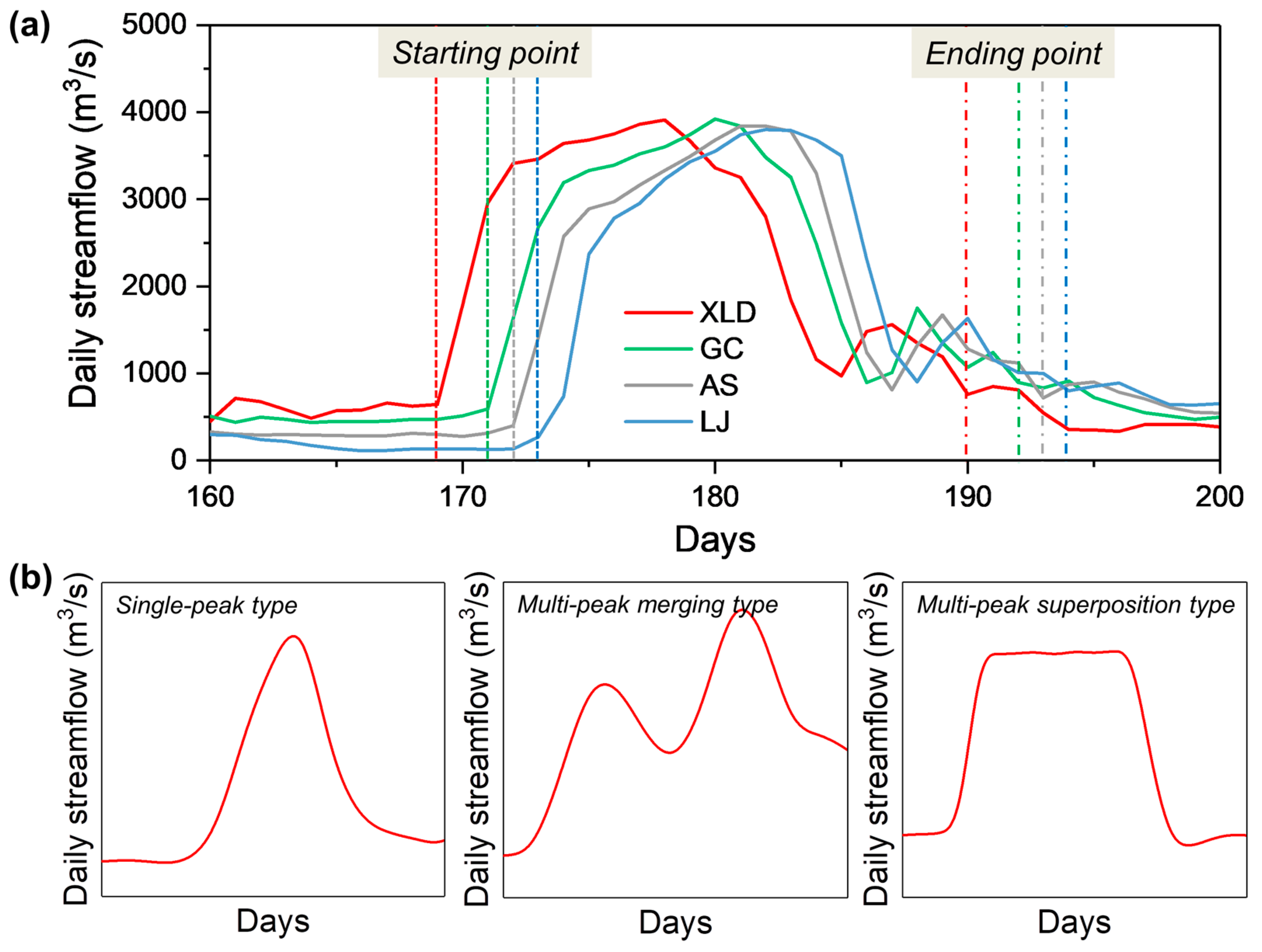

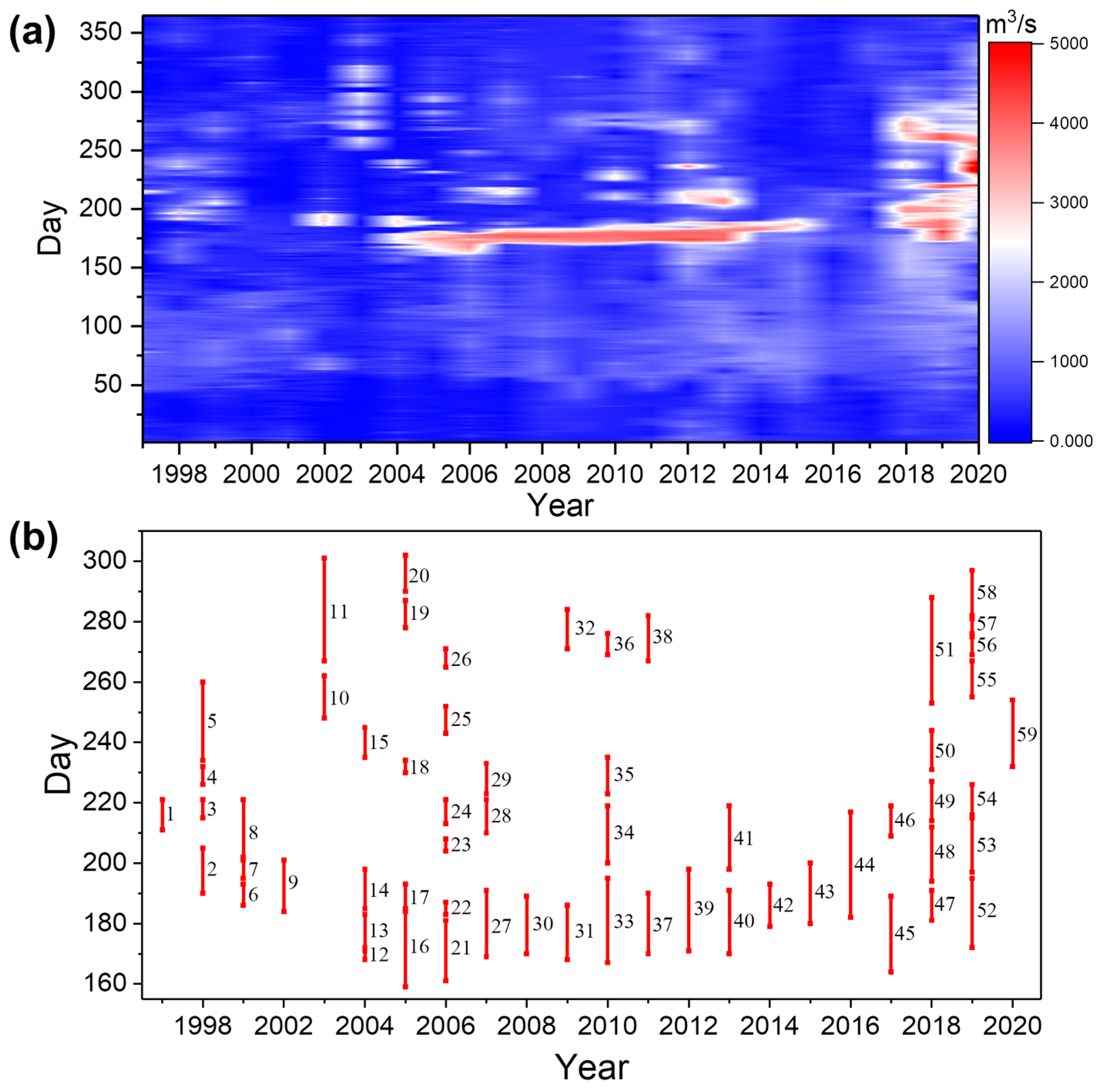
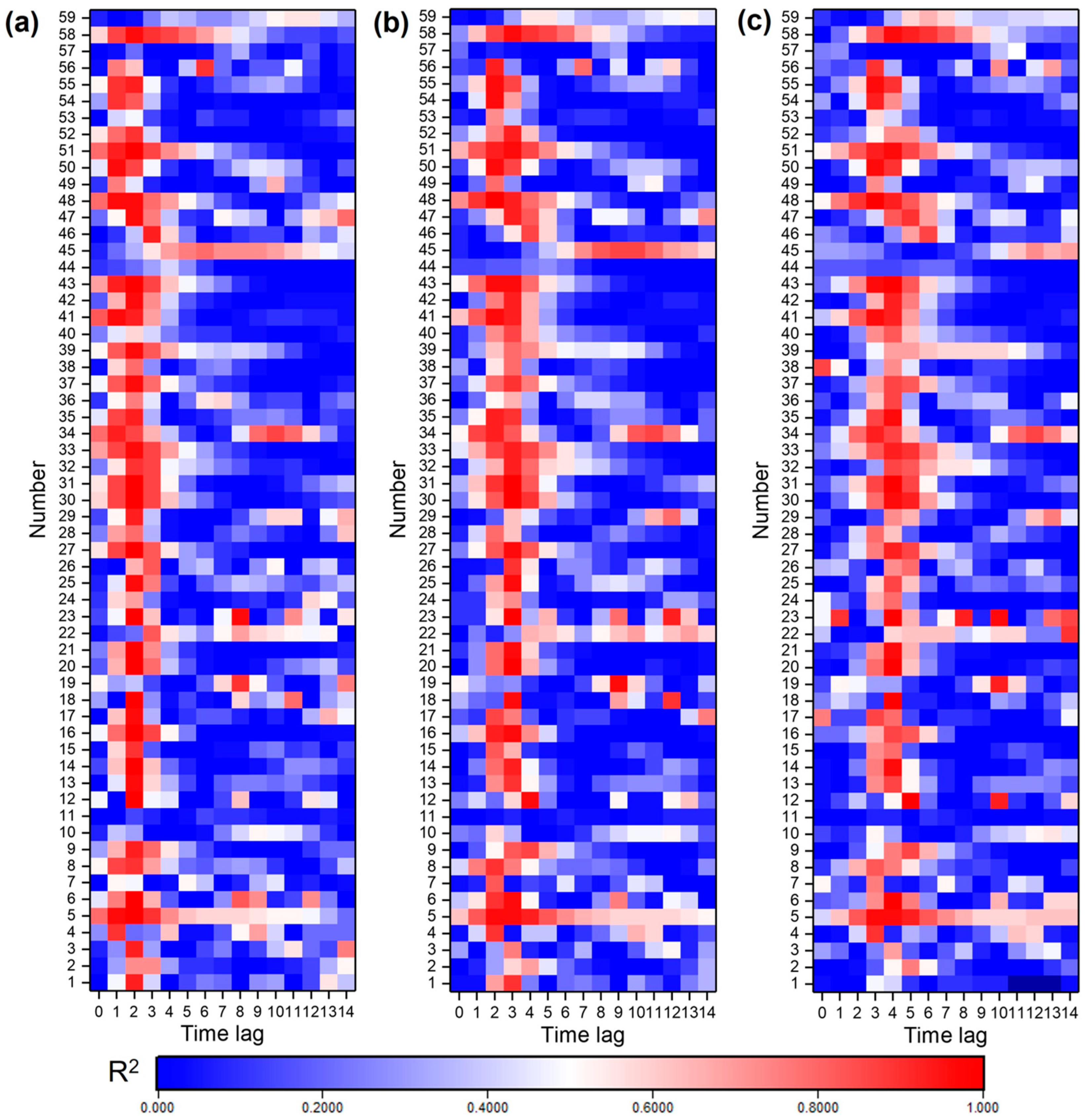
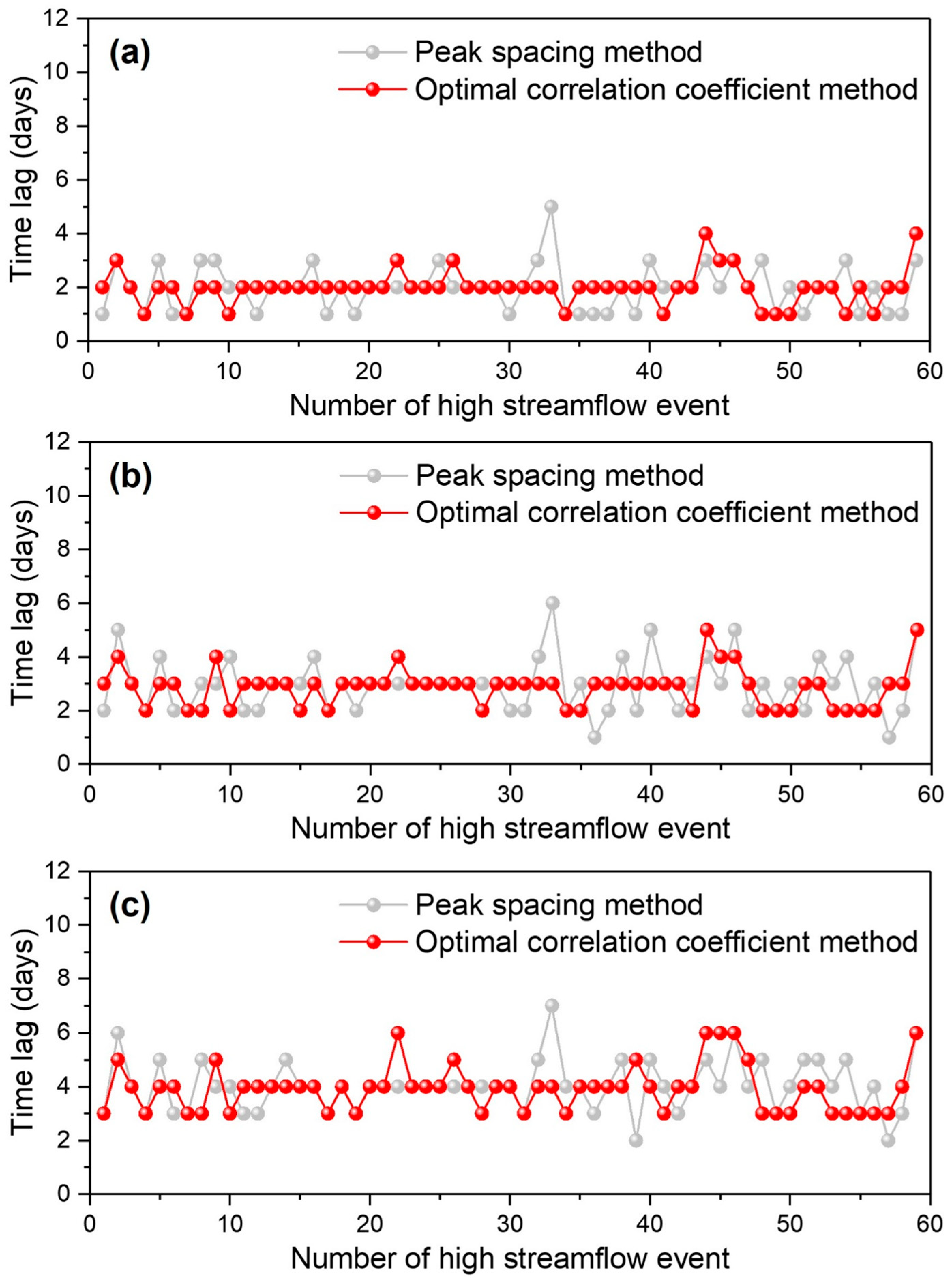
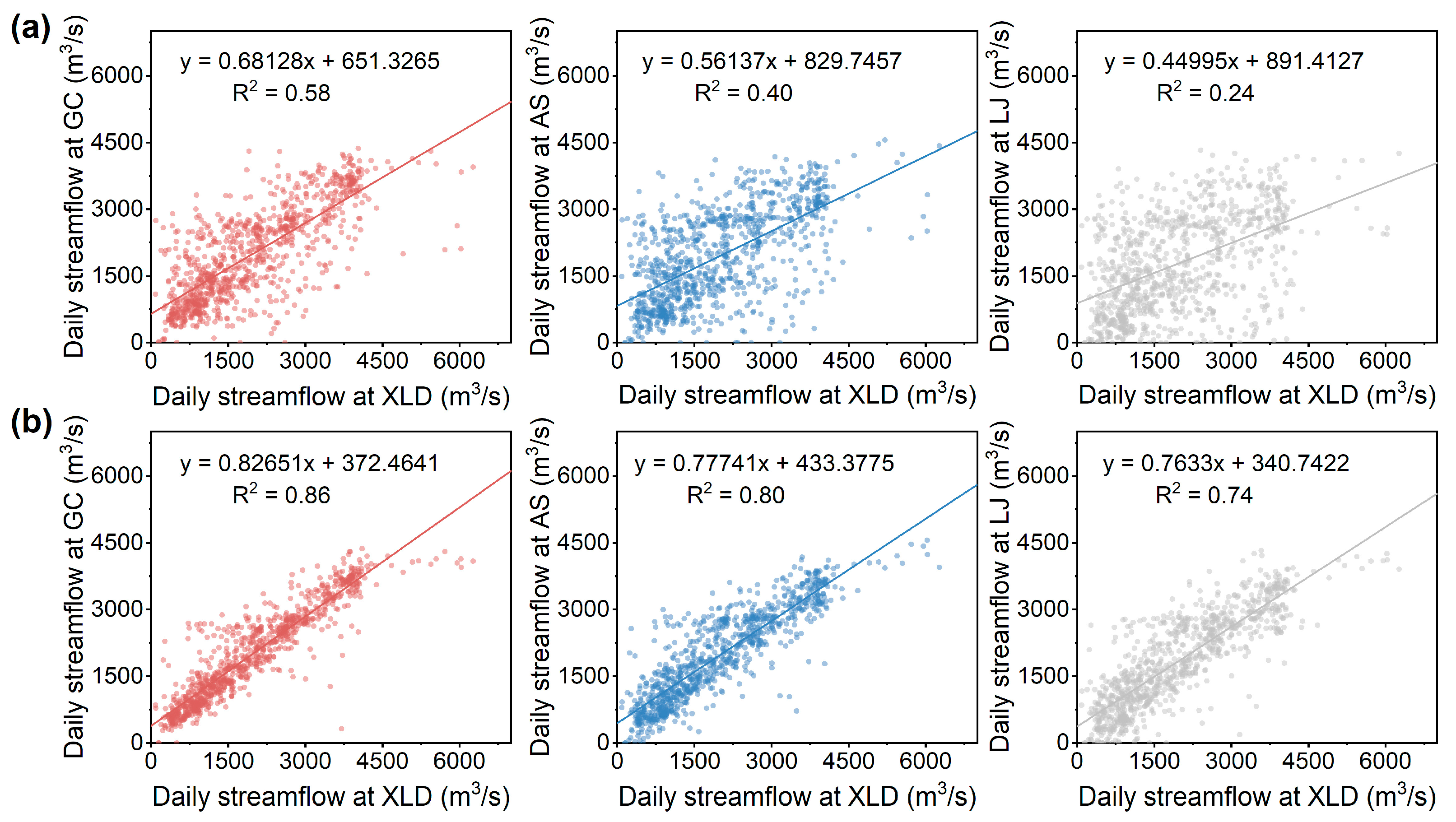
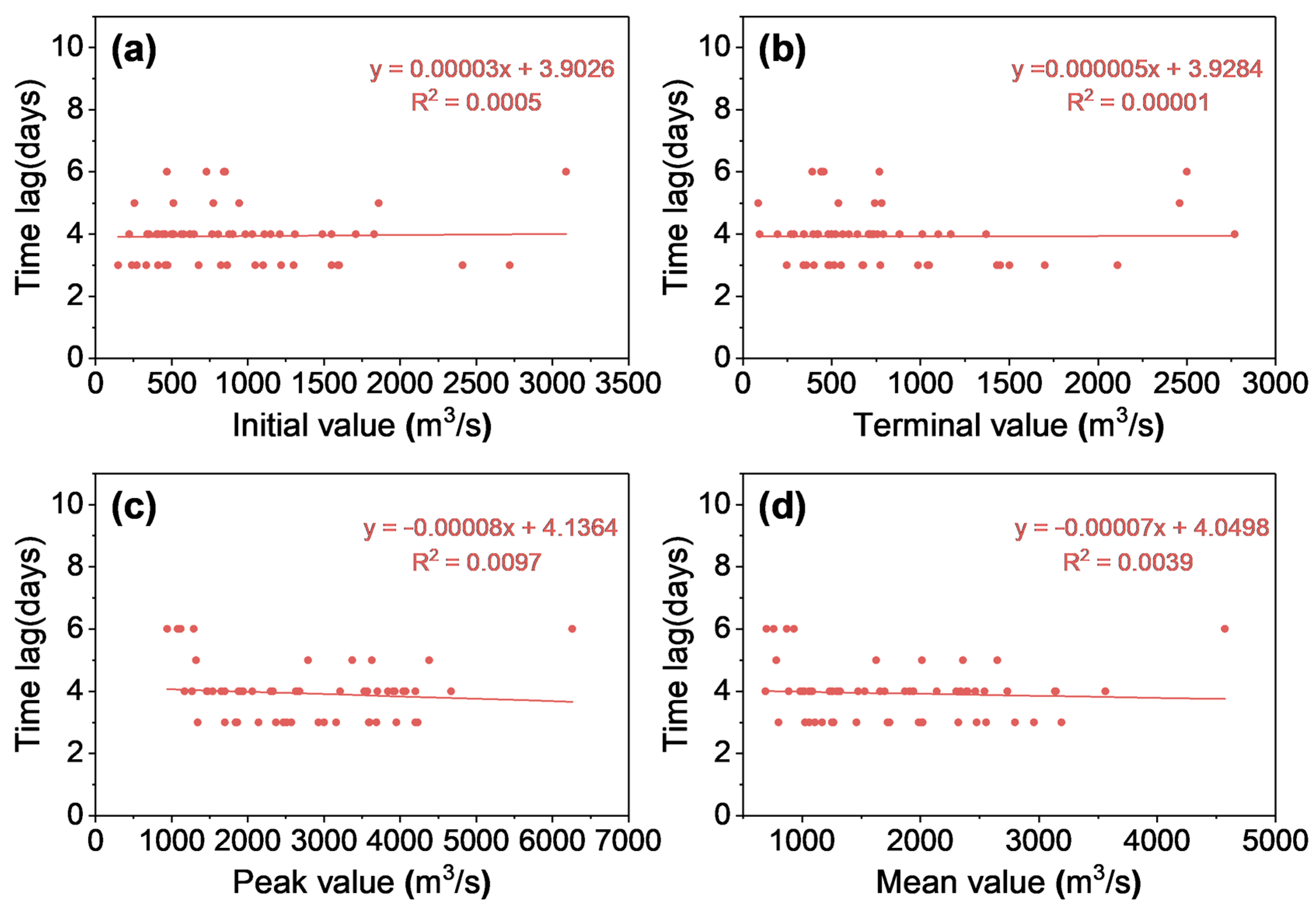
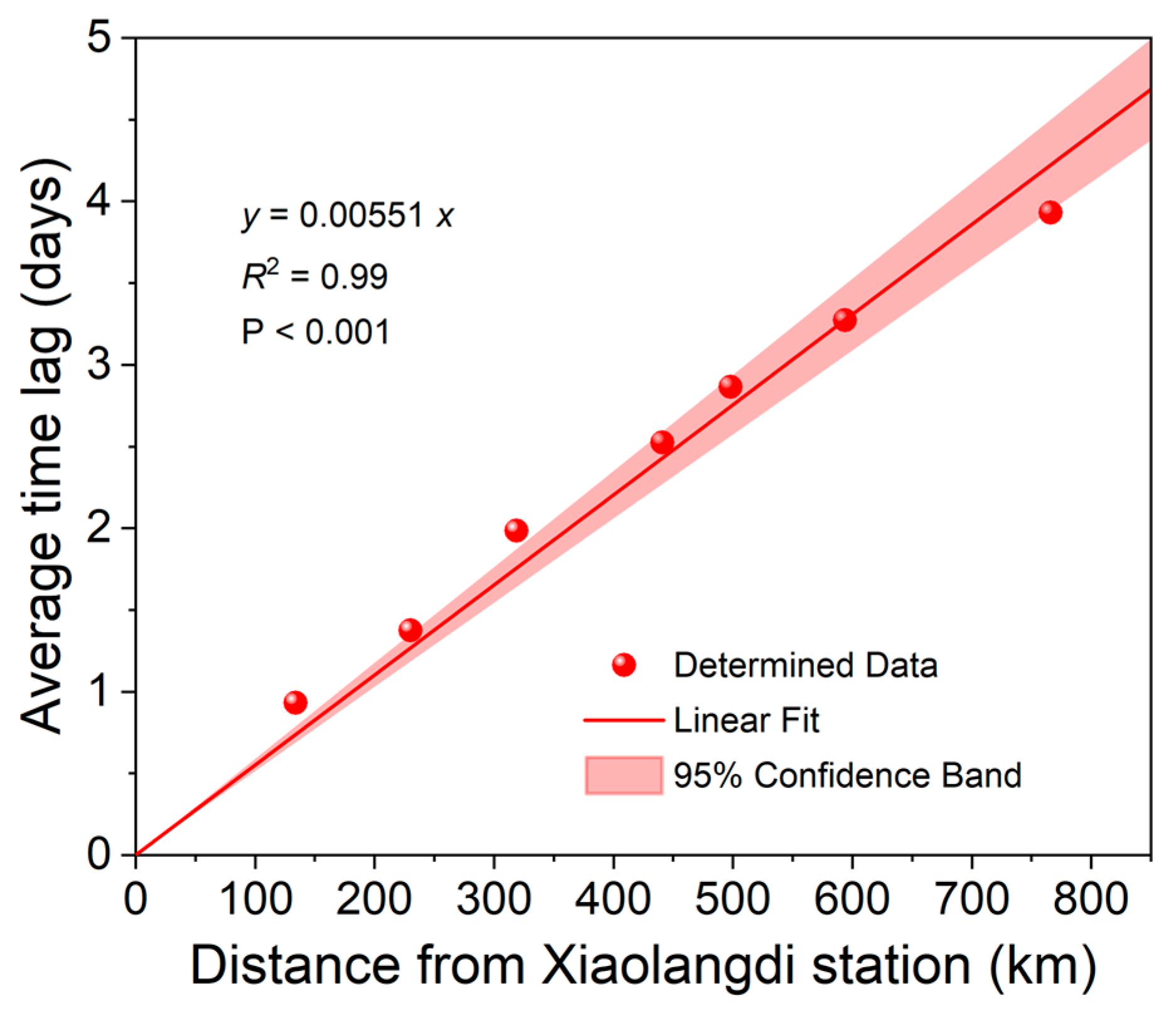
Disclaimer/Publisher’s Note: The statements, opinions and data contained in all publications are solely those of the individual author(s) and contributor(s) and not of MDPI and/or the editor(s). MDPI and/or the editor(s) disclaim responsibility for any injury to people or property resulting from any ideas, methods, instructions or products referred to in the content. |
© 2023 by the authors. Licensee MDPI, Basel, Switzerland. This article is an open access article distributed under the terms and conditions of the Creative Commons Attribution (CC BY) license (https://creativecommons.org/licenses/by/4.0/).
Share and Cite
Wang, J.; Xu, J.; Kong, D. Time-Lagged Response of Streamflow in the Lower Yellow River to the Water Regulation by Xiaolangdi Reservoir: Implication for Efficient Water Supply. Water 2024, 16, 78. https://doi.org/10.3390/w16010078
Wang J, Xu J, Kong D. Time-Lagged Response of Streamflow in the Lower Yellow River to the Water Regulation by Xiaolangdi Reservoir: Implication for Efficient Water Supply. Water. 2024; 16(1):78. https://doi.org/10.3390/w16010078
Chicago/Turabian StyleWang, Juan, Jinquan Xu, and Dongxian Kong. 2024. "Time-Lagged Response of Streamflow in the Lower Yellow River to the Water Regulation by Xiaolangdi Reservoir: Implication for Efficient Water Supply" Water 16, no. 1: 78. https://doi.org/10.3390/w16010078
APA StyleWang, J., Xu, J., & Kong, D. (2024). Time-Lagged Response of Streamflow in the Lower Yellow River to the Water Regulation by Xiaolangdi Reservoir: Implication for Efficient Water Supply. Water, 16(1), 78. https://doi.org/10.3390/w16010078




